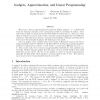Free Online Productivity Tools
i2Speak
i2Symbol
i2OCR
iTex2Img
iWeb2Print
iWeb2Shot
i2Type
iPdf2Split
iPdf2Merge
i2Bopomofo
i2Arabic
i2Style
i2Image
i2PDF
iLatex2Rtf
Sci2ools
SIAMCOMP
2000
2000
Gadgets, Approximation, and Linear Programming
We present a linear programming-based method for nding \gadgets", i.e., combinatorial structures reducing constraints of one optimization problem to constraints of another. A key step in this method is a simple observation which limits the search space to a nite one. Using this new method we present a number of new, computer-constructed gadgets for several di erent reductions. This method also answers a question posed by Bellare, Goldreich and Sudan 2] of how to prove the optimality of gadgets: LP duality gives such proofs. The new gadgets, when combined with recent results of Hastad 9], improve the known inapproximability results for MAX CUT and MAX DICUT, showing that approximating these problems to within factors of 16=17 + and 12=13 + respectively is NP-hard, for every > 0. Prior to this work, the best known inapproximability thresholds for both problems was 71/72 2]. Without using the gadgets from this paper, the best possible hardness that would follow from 2, 9] is 18=1...
| Added | 19 Dec 2010 |
| Updated | 19 Dec 2010 |
| Type | Journal |
| Year | 2000 |
| Where | SIAMCOMP |
| Authors | Luca Trevisan, Gregory B. Sorkin, Madhu Sudan, David P. Williamson |
Comments (0)

